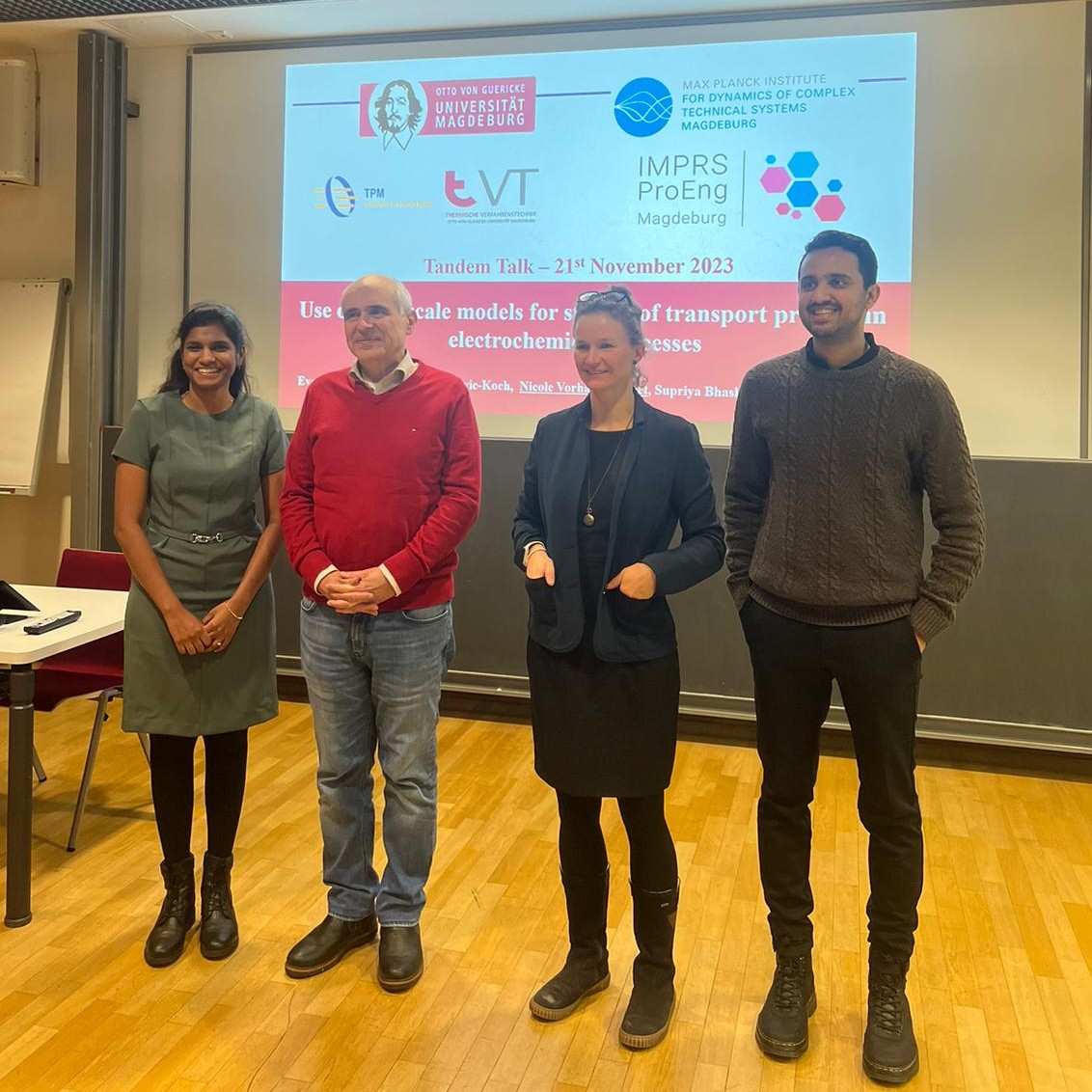Erstellt von Emad Aamer am 21.11.2023 um 10:00 Uhr:
On November 21th 2023 the IMPRS tandem talk featured the presentations by Supriya Bhaskaran, Haashir Altaf, Dr. Nicole Vorhauer-Huget, and Prof. Evangelos Tsotsas. The tandem talks, integral to the IMPRS program, provide a platform for researchers to share recent discoveries and address challenges.
Topics
- Investigation of Porous Media in Electrochemical Processes: Lattice Boltzmann Modelling and Experiments
- Investigating Porous Layers in PEM Electrolysers: Pore network modelling and Neutron Imaging
Abstract
The specific morphology of porous materials, as well as their physical properties, crucially affect their applications, e.g. their use in drying technology, packed beds, fuel cells, batteries, or electrolysers. A key point is the correlation of their transport properties with the spatially distributed pore structure. In polymer electrolyte membrane water electrolysers (PEMWE) and polymer electrolyte membrane fuel cells (PEMFC), the counter-current two-phase flow of water and oxygen inside the porous electrodes, can significantly control the performance of the system. More precisely, the temporal and spatially distributed product coverage of the catalyst layer obstructs the reactant supply towards it, which can result in a decrease in reaction rate. This can have a severe impact on the performance of the PEMWE and PEMFC as well as on the degradation of the catalyst material.
In these projects, Lattice Boltzmann Modeling (LBM) and Pore Network Modeling (PNM) is used to investigate the two-phase flow in the porous transport layer (PTL). The Lattice Boltzmann method (LBM) has emerged as a promising simulation tool for multi-phase flow in porous media. It is a mesoscopic model, which acts as a Navier-Stokes solver at the macroscale and considers inter particle forces between molecules at the microscale. LBM has the advantage that the realistic structure of the void space obtained from tomography techniques can be employed directly, which enables its application to strongly irregular pore structures. Here the invasion of O2 in a water-saturated anodic PTL is delineated with the implementation of the Shan-Chen multicomponent LBM
(SC-LBM) for PEMWE. Later, SC-LBM is applied for an in-depth understanding of the catalyst layer microstructure in PEMFC to reconcile the liquid-gas distribution during the very dynamic reaction mechanism. Thus, developed LBM to understand the two-phase transport and mechanism occurring at the CL and PTL precisely will have a significant impact on the development of energy storage devices. LBM is computationally more expensive. In the future, the developed model can be used to parameterize PNM and CM with effective invasion parameters.
In PNM, a pore network is constructed based on the information about porosity, pore size distribution, pore connectivity and pore shape, which are obtained from micro-computed tomography of commercial PTLs. A drainage algorithm is used to model the preferential pathway of oxygen through a water saturated PTL. Compared to existing macroscopic models, PNM is suitable for low capillary numbers, takes local wetting characteristics into account and resolves the invasion process at the pore scale. The quasi-static nature of the model provides an edge over direct numerical simulations in terms of computational power. With the help of PNM, it is studied how a change of structure, i.e. the spatial grading of the pore size distribution and porosity, affects the local oxygen and water distribution, as well as the transport properties. The transport parameters, such as permeability and thermal conductivity, can then also be extracted and used to parameterise the dynamic models to see the impact of PTL parameters on the electrolyser performance.
The two-phase flow is also analyzed experimentally by the use of a model electrochemical cell constructed and tested in-house at OVGU and MPI. A non-electrochemical aluminum cell is also employed in an in-situ neutron imaging setup installed at ILL, Grenoble, France. The outcomes of these study can be useful for the development of structural grading strategies with the target of improved transport properties for the efficient removal of the reactant oxygen and the homogeneous distribution of water. Furthermore, such experiments also help in validating the model assumptions.
